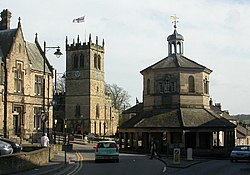Barnard Castle
| Barnard Castle | |
| County Durham | |
|---|---|
 Barnard Castle Market Place | |
| Location | |
| Grid reference: | NZ047166 |
| Location: | 54°33’-0"N, 1°55’12"W |
| Data | |
| Population: | 5,189 (2001) |
| Post town: | Barnard Castle |
| Postcode: | DL12 |
| Dialling code: | 01833 |
| Local Government | |
| Council: | County Durham |
| Parliamentary constituency: |
Bishop Auckland |
Barnard Castle is an historical town on the Tees in County Durham. It is named after the castle around which the town grew.
The town is found in a picturesque area of Teesdale and regularly attracts visitors from local areas and further afield. Its major sight is the castle. The town Is home too to the Bowes Museum.
Several holiday parks are located nearby including a Camping and Caravanning Club site. The town has several antique shops and an antique centre which attracts antique buyers from all around the world. It is also the site of a large pharmacetical manufacturing plant GlaxoSmithKline.
The town stands on the north bank of the River Tees, opposite Startforth, 34 miles south-southwest of Newcastle upon Tyne and 21 miles southwest of the county town of Durham. Its nearest large town is Darlington, 16 miles away.
Contents
History
The castle was founded by the Normans shortly after the conquest, but enjoyed its heyday under Bernard de Bailliol during the latter half of the 12th century. The castle passed into the hands of the Balliol family (of which the Scottish king, John Balliol, was the most important member), and then into the possession of Richard Neville, Earl of Warwick. King Richard III inherited it through his wife, Anne Neville, but it fell into ruins in the century after his death. The remains are now in the care of English Heritage.
Walter Scott frequently visited his friend John Sawrey Morritt at Rokeby Hall and was fond of exploring Teesdale. He begins his epic poem Rokeby (1813) with a man standing on guard on the round tower of the Barnard Castle fortress.
Charles Dickens and his illustrator Hablot Browne (“Phiz”) stayed at the King's Head in Barnard Castle while researching his novel Nicholas Nickleby in the winter of 1837-38. He is said to have entered William Humphrey's clock-maker's shop, then opposite the hotel, and enquired who had made a certain remarkable clock. William replied that his boy Humphrey had done it. This seems to have prompted Dickens to choose the title "Master Humphrey's Clock" for his new weekly, in which The Old Curiosity Shop and Barnaby Rudge appeared.
The Bowes Museum housed in a chateau-like building, was founded by John Bowes and his wife and is of national status. It contains an El Greco, paintings by Goya, Canaletto, Boucher, Fragonard and a collection of decorative art. A great attraction is the 18th century silver swan automation, which periodically preens itself, looks round and appears to catch and swallow a fish.
John Bowes lived at nearby Streatlam Castle (now demolished). His Streatlam stud never had more than ten breeding mares at one time, but produced no fewer than four Derby winners in twenty years. The last of these, "West Australian", was the first racehorse to win the Triple Crown (1853).
Culture
The annual live music festival, which is organised by Teesdale Community Rescources in conjunction with the Barnard Castle Meet Committee, runs over the Whit weekend alongside the many other 'Meet' activities. It is a three-day event with out-of-town bands playing on the Saturday and local bands & up and coming TCR bands playing on the Sunday and Monday. It is a family friendly event and entrance is totally free.
The Barnard Castle Meet is an annual carnival festival held on the second bank holiday weekend in May, the schools summer half term week. The Meet, as it is known locally, has grown from the North East Cyclists Meet dating back to 1885 and since the early 1900s the town has staged a carnival and grand procession through the town centre. This always falls on the bank holiday Monday. The weekend is now probably the largest event in the Barnard Castle and Teesdale calendar. The weekend encompasses around twenty separate events that the Meet Committee asserts 'reach every corner of the community'. In recent years with the demise of the R 'n' B festival from the Meet Weekend programme the Committee has staged its own music event showcasing local and national talent on the Sunday and Monday, with all technical and musical support from Teesdale Community Resources (TCR). The 2010 Meet, the largest for several years began with the Crowning of the Meet Queen on 29 May.
The Barnard Castle Band, founded in 1860, is a brass band based in the town, well-known outside the area as a result of the march Barnard Castle by Goff Richards.[1]